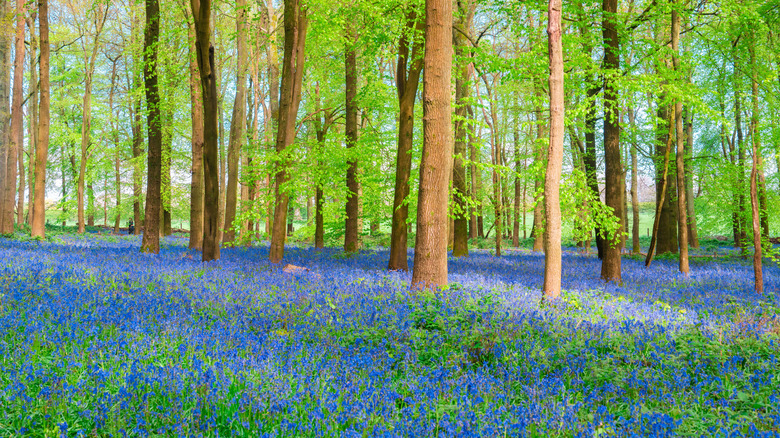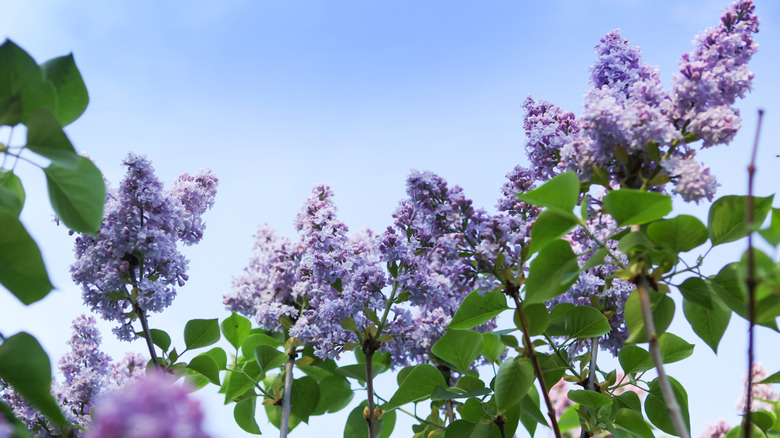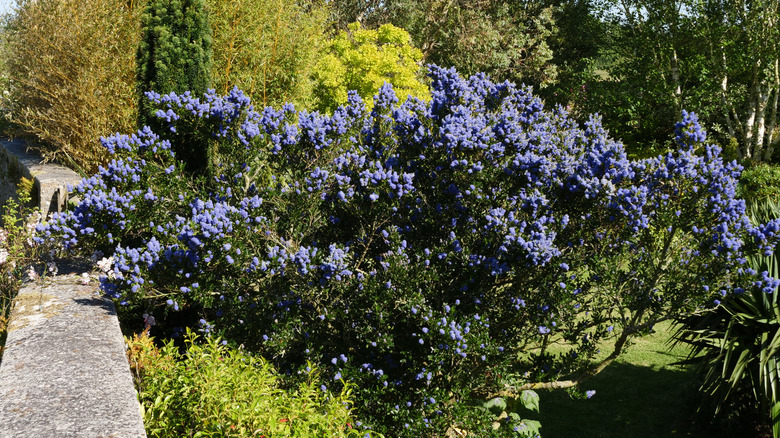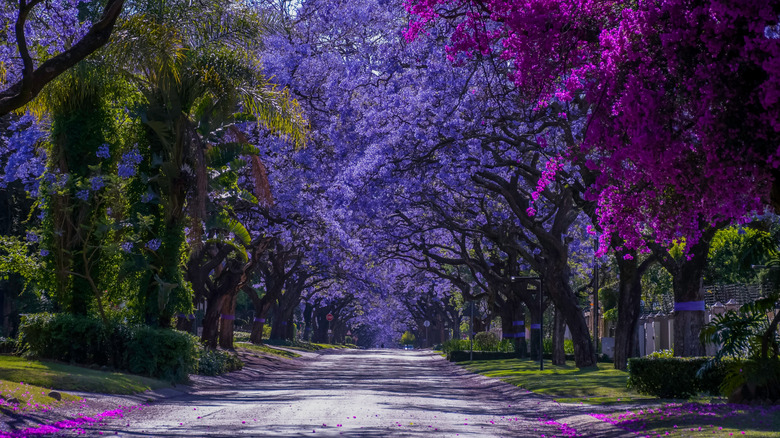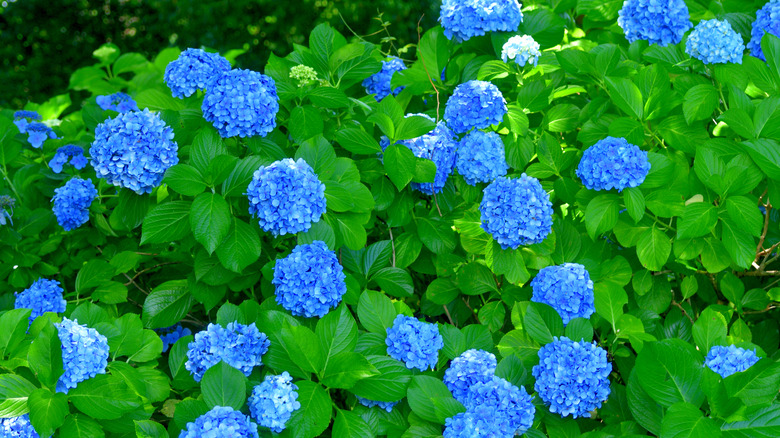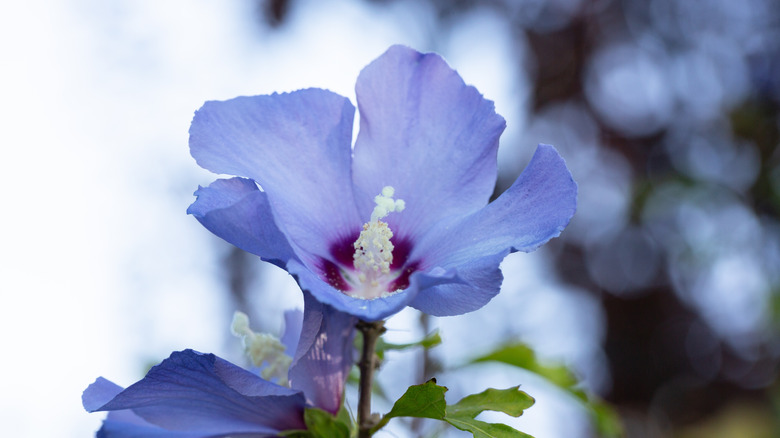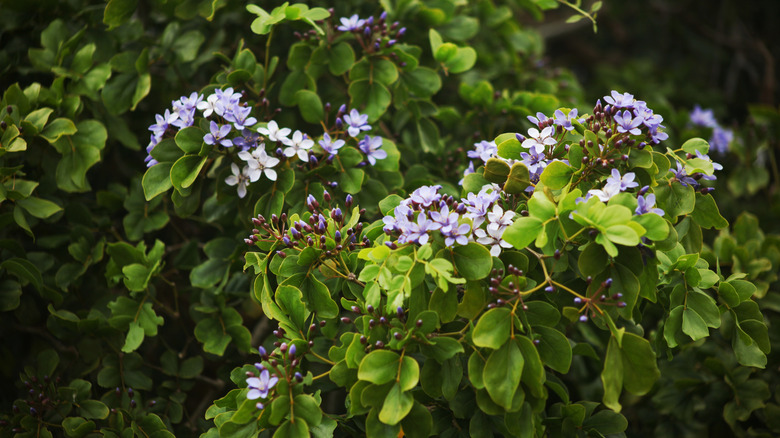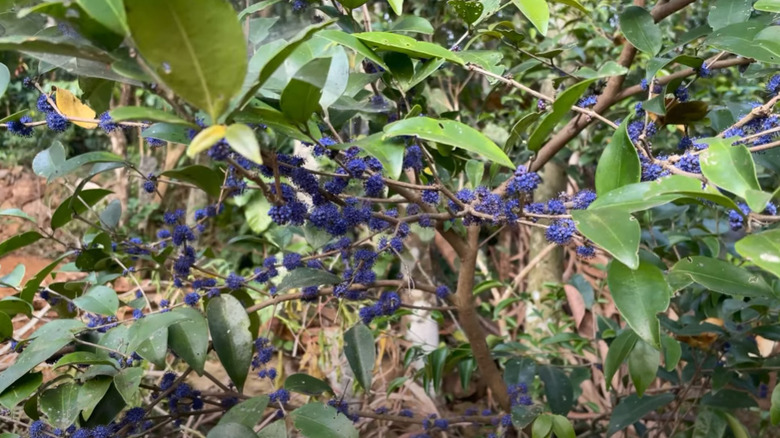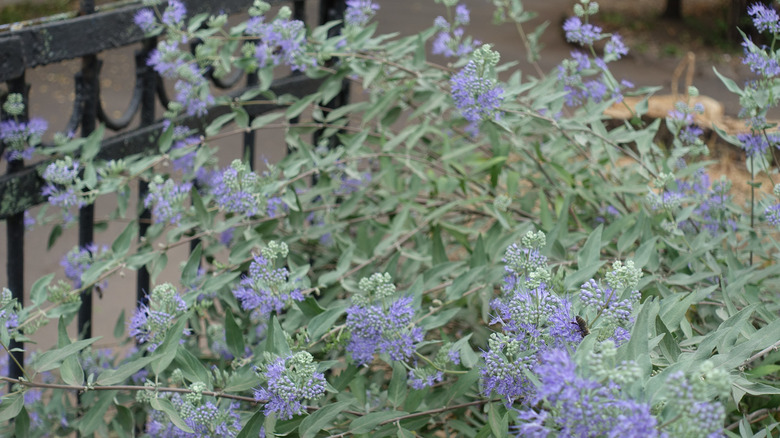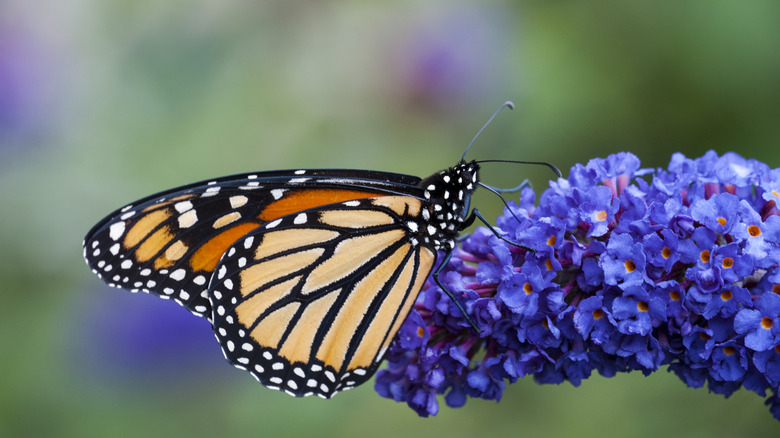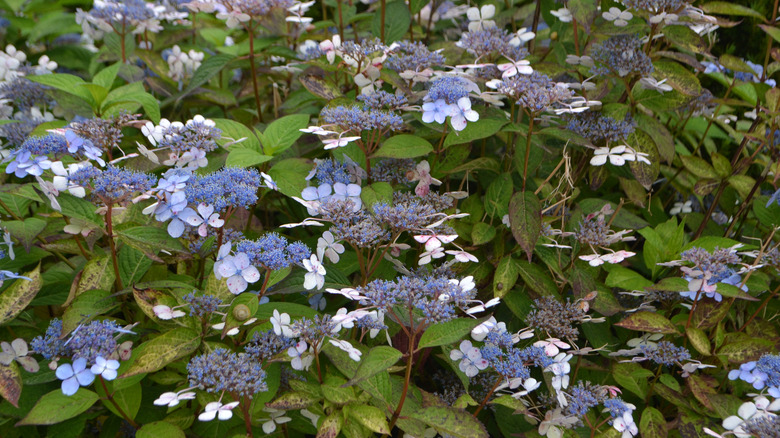11 Trees And Shrubs That Bloom With Beautiful Blue Flowers
There's just something about those first few peeks of vibrant color on a bush or tree that signal the official start of warmer seasons. And while, as a gardener, you're spoiled for choice as to what color palette you want to choose for your outdoor spaces, blue flowers are an excellent idea if you wish to craft a calm oasis in your garden. Blue's cool tones prompt a serene, meditative response, and what better way to de-stress than being awash in blue flowers in your own yard? Lucky for us, blue pops up in a number of different plants and is often the most impactful (and abundant) in trees and shrubs.
Trees and shrubs lend your gardens a ton of visual impact. While other landscaping components, like ground covers in flower beds, also help to make a garden attractive and functional, we wanted to explore blue flower choices that would provide a large concentration of statement blooms for your outdoor space. Shrubs (bushy, woody plants that are taller and denser than an average bush) and ornamental trees are the "large and in charge" focal points of your landscaping. Your eyes are immediately drawn to these features. Moreover, they provide a ton of shade and cover, and as we mentioned, plenty of serenity. Thus, our favorite blue blossoms on this list, from classic Hydrangeas to whimsical beardtongues, are some of the best statement-making choices out there.
Common lilac
Common lilac (Syringa vulgaris) is a tree that blooms during the late spring and early summer with delicate, yet fragrant violet-blue flowers. A great candidate for pollinator gardens in hardiness zones 3 to 7, these perfumed beauties enjoy full to part sun and neutral to slightly alkaline soil conditions. They are relatively easy to care for, as long as you avoid common lilac care mistakes, like improper pruning or excessive fertilization. Just be sure to steer clear of the Japanese lilac (Syringa reticulata), which is considered invasive in parts of the Northeast.
California lilac
The California lilac (Ceanothus) is another blue-flowered springtime bloomer to consider for the garden. Its petite blossoms resemble those of its lilac cousin but are even bluer than what you can expect from common lilac trees (which are a different genus). Ceanothus prefers warmer climates, thriving in hardiness zones 7 to 10. California lilacs also grow quite fast and can reach heights of anywhere from 2 to 20 feet in some cases — a variable to consider if you have specific landscape designs in mind.
Jacaranda
Jacaranda (Jacaranda mimosifiola) is a hardy tree that can reach heights of 25 to 50 feet. Native to South America, this tree does well in hardiness zones 10 and 11, where it thrives in the high heat and humidity. Another late spring to early summer bloomer, Jacaranda fills with beautiful, bell-shaped blossoms that coat its branches with thick clouds of blue. Be forewarned though, while these trees are stunning, their blue blooms will fall in droves onto the surface below, so your yard may require extensive cleaning come blooming season.
Bigleaf Hydrangea
The mop-head blooms of bigleaf Hydrangeas (Hydrangea macrophylla) famously change color depending on the soil's acidity, which is part of the plant's charm. However, it can be challenging if you have a particular color palette in mind, since getting this plant to produce blue flowers requires effort. You can nudge your Hydrangeas towards the blue side of the spectrum by making your soil more acidic — to a Ph below 6.5 — with aluminum sulfate. Hydrangeas do well in hardiness zones 6 to 11, and their flowers are a vibrant true blue.
Rose of Sharon
Rose of Sharon is one of the many names Hibiscus (Hibiscus syriacus) goes by, but this tropical favorite is universally known for its large, beautiful flowers. This deciduous shrub is commonly associated with paradises like Hawaii, but it grows well in hardiness zones 5 to 8. While Hibiscus flowers come in a number of colorful varieties, with different petal shapes and sizes, the 'Blue Chiffon' cultivar features bluish hues. Note that the Rose of Sharon is listed as invasive in a number of eastern U.S. states and growing it there could be harmful to local ecosystems.
Guaiacum
Guaiacum (Guaiacum officinale) is a tree that goes by many names, one of which is lignum vitae — which means "the tree of life" in Latin. Known as such for its beautifully colored timber and various medicinal properties, Guaiacum is native to South America and the Caribbean. It features small clusters of deep-blue-toned flowers, and as the blossoms age (usually the flowers live on the branch for a while), the color of the petals desaturates to a lighter blue. A great evergreen addition for zones 10 to 12, Guaiacum can grow tall — upwards of 30 feet — though it'll do so slowly.
Ironwood
Not to be confused with the famous tree varieties of the same name native to the Chicago area or the Sonoran Desert, this ironwood (also called ironweed) refers to the South Asian Memecylon umbellatum (also called Memecylon ovatum) tree. It produces small, fluffy clusters of vibrant blue and pink blossoms that emerge in the late winter and early spring in the warmer climates of zones 10 to 11. This tree can grow up to 40 feet, attracts pollinators, and has saturated, waxy leaves that remain green throughout the seasons, retaining the tree's ornamental value year-round.
Blue mist shrub
The blue mist shrub (Caryopteris x clandonensis), also known as bluebeard and blue spirea, is a low-growing shrub that only gets to be around 3 feet tall but grows relatively quickly. As a part of the mint family, the speed at which it grows and its dense mounding structure shouldn't be a surprise, and thus it serves as a great border plant. There are several additional benefits to planting the blue mist shrub aside from its delicate violet-blue flowers — deer tend to not care for it and it's resilient against drought, pests, and disease.
Butterfly bush
If you couldn't tell from its name, the butterfly bush (Buddleia davidii) is a small but mighty bloomer that attracts scores of butterflies with its bountiful nectar supply. A shrub that often won't get taller than 10 feet (dwarf plants stay even smaller) the butterfly bush comes in a number of colors. Certain cultivars, like the 'Pugster Blue', produce deep indigo-blue flowers, while others lean more true purple, red, white, pink, or yellow. Butterfly bushes grow well in hardiness zones 5 to 10.
Blue beardtongue
Beardtongue (Penstemon) is a tall evergreen shrub, which, like Hibiscus and butterfly bushes, has flowers that come in a number of colors. One particular cultivar, 'Electric Blue,' has pastel blue, purple, and pink trumpet-shaped blooms. With its shape and coloration, this tall and slender shrub looks like it's been plucked straight out of "Alice in Wonderland." You can expect its Cheshire Cat-colored flowers to bloom in the spring and summer in hardiness zones 5 to 8. As a bonus, you'll attract both pollinators and songbirds with these blue blooms.
Mountain hydrangea
Much like the classic, big leaf Hydrangea we mentioned earlier, the mountain Hydrangea (Hydrangea serrata) also impresses with its blue blooms. A variety that's originally from Japan and Korea, this Hydrangea plant features much smaller, more slender leaves and tufts of delicate lacecap flowers. It is a summer bloomer, growing well in hardiness zones 6 to 9, and as is the case with its bigleaf cousins, the flower color will change based on the acidity of the soil. It's not uncommon for the bloom cluster to even change colors throughout the season, making these Hydrangeas a whimsical addition to your serene garden.
